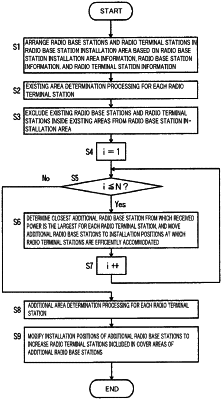| CPC H04W 16/18 (2013.01) [H04W 24/02 (2013.01)] | 9 Claims |

|
1. A wireless base station installation position computation method for computing installation positions of additional wireless base stations that are to be additionally installed, without moving existing wireless base stations that are already installed in a wireless base station installation area, the wireless base station installation position computation method comprising:
a step 1 of performing processing for determining wireless terminal stations that are inside the cover areas of the existing wireless base stations, and excluding the existing wireless base stations and the wireless terminal stations inside the cover areas from the wireless base station installation area;
a step 2 of performing processing for optimizing, with respect to each first wireless terminal station that is outside the cover areas of the existing wireless base stations and has been left as a result of the processing for excluding in the step 1, a combination of the first wireless terminal station and the closest additional wireless base station from which received power is the largest, and optimizing installation positions of the additional wireless base stations; and
a step 3 of determining, with respect to the combinations of the additional wireless base stations and the first wireless terminal stations that were optimized in the step 2, wireless terminal stations that are inside and that are outside the cover areas of the additional wireless base stations, and performing processing for modifying an installation position of the additional wireless base station that accommodates a second wireless terminal station that is outside the cover area to increase the number of wireless terminal stations included in the cover areas.
|